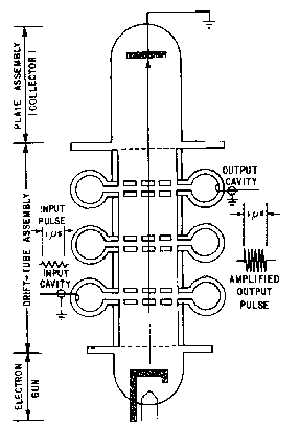2-12
Q-12. The electrons in the beam of a klystron are speeded up by a high dc potential applied to what
elements?
Q-13. The two-cavity klystron uses what cavity as an output cavity?
Q-14. A two-cavity klystron without a feedback path will operate as what type of circuit?
The Multicavity Power Klystron
Klystron amplification, power output, and efficiency can be greatly improved by the addition of
intermediate cavities between the input and output cavities of the basic klystron. Additional cavities serve
to velocity-modulate the electron beam and produce an increase in the energy available at the output.
Since all intermediate cavities in a multicavity klystron operate in the same manner, a representative
THREE-CAVITY KLYSTRON will be discussed.
A three-cavity klystron is illustrated in figure 2-8. The entire DRIFT-TUBE ASSEMBLY, the three
CAVITIES, and the COLLECTOR PLATE of the three-cavity klystron are operated at ground potential
for reasons of safety. The electron beam is formed and accelerated toward the drift tube by a large
negative pulse applied to the cathode. MAGNETIC FOCUS COILS are placed around the drift tube to
keep the electrons in a tight beam and away from the side walls of the tube. The focus of the beam is also
aided by the concave shape of the cathode in high-powered klystrons.
Figure 2-8.—Three-cavity klystron.

